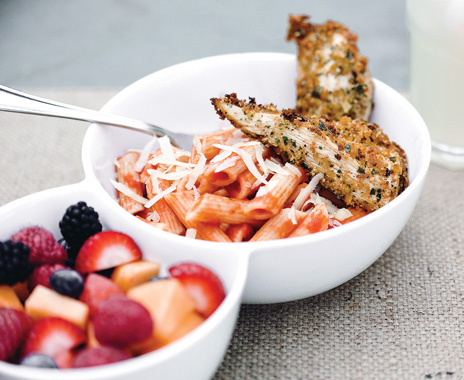As healthier, more wholesome eating habits become top of mind for consumers, many parents are seeking out healthy, nutrient-dense options for their children on restaurant menus—and operators are listening.
At Dallas-based sandwich chain Which Wich, the children’s menu was overhauled in an effort to improve the nutritional quality of its offerings. Children were previously only given the option of potato chips or pretzels as a side, but now they also have the option of fresh apple slices or baby carrots.
Which Wich also added meat and cheese “rollups” to its kids’ menu, which eliminates the bread included in a typical sandwich.
These changes were made after Which Wich CEO Jeff Sinelli and his wife, executive vice president Courtney Sinelli, realized that they wanted to develop a kids’ menu that they would feed their own two children.
“I’ve got a theory,” Jeff Sinelli says. “If you’re going to spend a dollar on any advertising or marketing, spend that dollar toward children, because you’re going to have a long-term effect that the kids market to their parents by the affinity and love for the brand. We took a hyper focus on it because we have a family, and because we care about our kids and what they’re eating.”
Christina Economos is an associate professor in the Friedman School of Nutrition Science and Policy at Tufts University, as well as director of ChildObesity180, a national nonprofit initiative that works to prevent obesity in children. She believes that changes being made within the foodservice industry are moving in the right direction, but that a lot of work is left to be done.
“There’s no question that the new generation of younger parents with young kids who want to eat healthier are seeking out where they can find those foods in restaurants,” Economos says. “The truth is we eat out a lot in America, and that’s probably not going to change, so people want to feel that they can find what they want outside of the home. And they don’t just want those changes for their own food; they want them for their kids as well.”
Economos says healthy options need to be more prevalent on menus (composing at least half of the options provided) and that desserts should shift from being automatically included with a kids’ meal to becoming an à la carte option.
In a study focusing on the calories in kids’ meals offered in 2014 at popular restaurant chains, Economos and her coauthors found that 72 percent of quick-service kids’ meals had 600 calories or less; however, only 32 percent met the recommended guidelines for fat, saturated fat, and sodium.
“There is pretty clear evidence published that when children eat out at restaurants, they are consuming more calories,” Economos says. “The more we generate that evidence and then bring it into the public space and have it written about, the more the industry can realize that it’s important to reformulate and be part of the solution.”
In 2004, Chick-fil-A was the first quick serve to introduce a fruit cup on its menu. The chain has since switched from 2 percent to 1 percent milk, as well as offered grilled chicken nuggets as an entrée option.
“People aren’t just looking for lower-calorie options; they also want to know what’s in their food,” says Paul Trotti, director of menu strategy at Chick-fil-A. “Consumers have gone from counting calories to counting ingredients. We’re listening, and have actively been updating our menu for the past several years.”
Trotti says customers have been requesting cleaner, more nutrient-dense options. In 2014, Chick-fil-A announced it will be serving chicken with “no antibiotics ever” by the end of 2019. The brand’s suppliers will not use antibiotics of any kind at any point in the chicken’s life cycle—starting from the egg.
Trotti says there is one thing that must never be lost along the way: taste.
“While we are focused on adding healthy options to the kids’ meal, we also know that if the food doesn’t taste good, kids won’t eat it,” he says. “So we are dedicated to a menu that is not only health-conscious, but also tastes great.”
At Grown, a Miami-based restaurant founded by former NBA player Ray Allen and his wife, Shannon, the word healthy is banned because they believe the term is subjective.
“Each child is different, and only their parents and health practitioners know what is healthy for them. It’s not for me to define what your children should be eating—only you know that,” Shannon Allen says. “What I do feel responsible for is providing your family a plethora of 100 percent organic, freshly prepared, delicious, and nutrient-dense items that you can choose from.”
The Allens were inspired to open Grown because of their son’s battle with Type 1 diabetes. The family had trouble finding nutrient-rich fast food that would meet his dietary needs, so they decided to open a restaurant that would serve healthy food at an affordable price.
Most of the restaurant’s ingredients are USDA-certified organic. Everything on the menu can be ordered in a child’s portion. But while some children ask for salmon with broccoli and black beans for dinner, Allen says, most children just want chicken tenders. Grown offers organic, panko-breaded chicken tenders, which she believes parents will not feel guilty feeding to their children.
“I think restaurants all over the country are responding to the demands of the day,” she says. “The busy mom has spoken. She wants better options for her family, she won’t accept compromise, and she’s willing to seek out a product she feels good about.”













